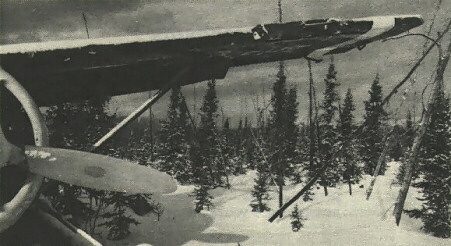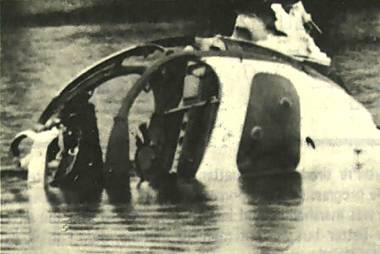From Issue 6/75

There's a school of thought which goes "you can't avoid having accidents", and we must admit that statistical evidence seems to be on their side. But a close look at accidents reveals that few, if any, ever needed to have taken place.
It's our firm opinion that assuming the inevitability of accidents saps the positive thinking of those who are in the best position to prevent them. Persons involved in accidents sometimes reveal a startling lack of appreciation for this fact. You'll hear "Some kinds of flying are dangerous; you only have to look at the accident record to see that"!
Take the pilot who lands a small ski-equipped cargo plane at a remote frozen lake. On landing he discovers that the surface is quite slushy and that he has picked up a fair amount of the stuff during the landing roll. He unloads his cargo, kicks off the accumulation around the skis and sets out for the takeoff. On his first attempt he gets nowhere so he decides to use the landing tracks. This time, things go a little better but acceleration is still poor. With only 250-300 yards of lake remaining at 40 mph "I elected to carry on and obtain 50 mph and rotate...". Inasmuch as there was a shoreline and trees at the end of the lake, that attitude took some self-control! The aircraft became airborne for a short distance but was so close to the stall that the aircraft wouldn't accelerate. The inevitable happened and the aircraft crash-landed into trees.
It was the pilot's contention that "I honestly don't know how this could have been avoided in this situation...". And he's right. The problem is that the pilot meant by "situation" the compelling urge to make good a takeoff run which obviously wasn't going well, and indeed, to attempt a takeoff in conditions like that in the first place. Certainly, there was pressure to get the aircraft out, but as it happened it stayed there for quite a while longer.
Originally Published: ASL 1/1998
Original Article: From Issue 6/75
From Issue 3/75
"Runway Lights in Sight..."
Last year 97 people were killed when a 707 entered a particularly steep rate of descent in the last 20 seconds of an instrument approach. As the runway became visible the first officer called "you're a little high", so the captain increased his rate of descent from 690 fpm to 1470 fpm. This excessive descent continued until the aircraft crashed.
Why? The captain had relied primarily on visual clues. The heavy rain on the windshield may have caused the runway lights to appear larger, thereby convincing the pilot he was cioser to the runway than he reallv was.
"Runway lights in sight..." is a reassuring call from the first officer but it means you're entering a critical phase of flight. That transition from instruments to the visual part of the landing requires more than just a casual check of the flight instruments. Your instrument scan should continue, adding to it visual clues (such as VASI) as they appear. This way, during transition you'll detect any deviations from the glidepath and desired rate of descent.
Having some visual clues may tempt you to abandon your instrument scan early but rain on the windshield changes the perception of distance on the approach. It can make lights appear larger which may convince you the runway is closer than it really is. With this iilusion it's easy to convince yourself to increase the rate of descent or descend prematurely. Or rain may cause runway lights to appear less intense by diffusing their glow. This would probably lead you to think that the lights are farther away than they actually are.
Don't fall into the visual trap. Maintain a good scan of your flight instruments as you transition from instrument phase to the visual approach and landing.
The Mirror Effect
Have you ever looked into a wall-to-wall mirror and wondered exactly where the surface was? Hard to tell, isn't it? It's the same thing when taking off or landing on glassy water.
Ask any experienced float pilot - glassy water operations are tricky and you need to be extra alert. Here's an example. After refuelling on shore, a chopper pilot moved to a hover over a glassy lake surface. As he began h is transition to forward flight the skids struck the water surface causing the chopper to tumble into the water. Fortunately the crevv escaped uninjured as the chopper was sinking.
The pilot said he had never been instructed on the hazards associated with glassy water operations. Have you? There is more information on this subject in Part 4 of the Flight Information Manual (FIM).

Originally Published: ASL 1/1998
Original Article: From Issue 3/75 - "Runway Lights in Sight..."; The Mirror Effect
Fuel Tanks - AVGAS Water Contamination - AVGAS Water Contamination
Getting airborne was easy. It was the forced landing 15 minutes later that sent the adrenaline flowing into this pilot's blood. At the first sign of rough running, carb heat seemed to work..., then I lost all power except a very faint idle. I picked out a field and made a forced landing. The next day they found ice in the fuel filter and sediment bowl; in fact, the wing tank drains were frozen and there was ice in the bottom of both tanks.
The aircraft was parked on the ramp throughout the winter. After most flights it was left with fuel tanks less than half full. On this aircraft type as on many others the fuel caps are recessed below the wing surface, leaving space for the collection of rainwater. Removal of the cap without first drying out this recess would permit water to dribble into the tank. In addition, the tank cap seals were in poor condition. The night before the incident the aircraft had been towed into a heated hangar for repairs and by flight time it was thawed out. The rapid change in temperature and exposure to the elements resulted in a build-up of water from condensation and seepage. After refuelling, the stirring action in the tanks will put the water in suspension; before draining the sumps wait a few minutes for any water to settle.
Originally Published: ASL 1/1998
Original Article: Fuel Tanks - AVGAS Water Contamination
Updating Your Global Positioning System?
The following was taken from a daily occurrence report:
In IFR conditions, a Saab 340 with 20 people on board was cleared for the approach into an MF [mandatory frequency] aerodrome. It was on short final when the FSS staff observed a Robinson RH22 inbound near the approach path to the runway.
The helo was not in radio contact with FSS and was not monitoring the MF. The Saab pilot was able to land safely and saw the helicopter on short final.
FSS staff approached the pilot of the helicopter after it landed and the pilot said [that] he had been communicating on 118.0 [MHz] (that frequency had been decommissioned [three] years previously). He said [that] this frequency was provided by his GPS equipment, but, on [being] questioned, admitted that the GPS database had not been updated for "a couple of years." He did not consult his copy of the [Canada] Flight Supplement, which was on the seat beside him, because he was "too busy." When FSS staff asked for his name, the pilot declined to give it, and said [that] "[he hoped] nothing would come of this.
Upon departure, the pilot did not file a flight plan; rather, he flew on a company flight note.
Weather at the time of the incident was 700 ft. broken [and] 2000 ft. overcast, [with] visibility 5 mi. in light rain and fog.
Communicating on the right frequency in an MF is mandatory, but it should also be too easy. Having an up-to-date Canada Flight Supplement and looking at it or getting your GPS database updated regularly may cost a few dollars, but a mid-air collision could ruin the day for a lot of people.
Originally Published: ASL 4/1997
Original Article: Updating Your Global Positioning System?




























